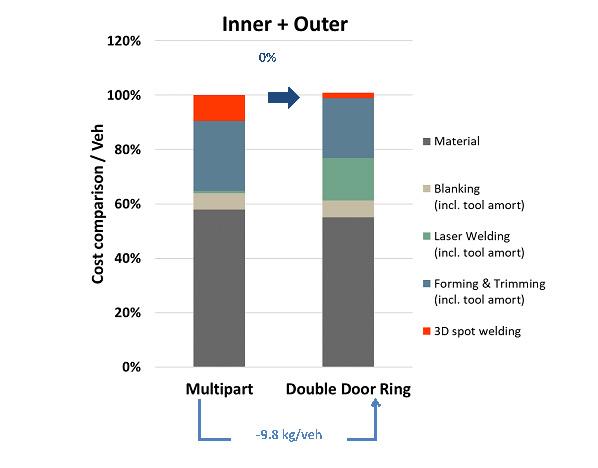Products
Product pages available in
EN - DE - FR - ES
Sustainability
News, events and stories
Double door ring
ArcelorMittal engineers have applied the MPI concept to a double door ring – the biggest part of a car’s structure and one of the most difficult parts to make. The double door ring is composed of an inner and an outer door ring. Each ring is made of many sub-parts which need to be welded together to form the final part.

The MPI door ring reduces the number of spot welds from 310 to just 66 per vehicle
The MPI concept radically simplifies the production process by reducing the number of sub-parts needed for each door ring. MPI cuts the number of components from 13 per side to just four. This leads to significant sustainability gains and potential cost savings.
The MPI double door ring has significant advantages as it:
- Reduces the number of spotwelds from 310 per vehicle to just 66 – a reduction of almost 80 percent
- Cuts the overall mass of the body-in-white by 9.8 kilograms using ArcelorMittal’s latest PHS steels and laser welding technology
- Is compatible with any powertrain.

While the costs do not change, a weight saving of 9.8 kg can be achieved for each vehicle
Validation against international requirements
Like all MPI designs, the double door ring solution has been validated against relevant safety requirements for the global market. For the double door ring, the tests included:
- IIHS roof crush
- IIHS small overlap rigid bar (SORB)
- Euro NCAP advanced European moving deformable barrier (AE-MDB) 2020
- USNCAP Pole 50th
- IIHS moving deformable barrier (MDB).
Nesting reduces material use
By optimising the nesting of the parts, the material utilisation rate is increased by five percent for the inner ring and four percent for the outer part. Overall, the changes reduced the amount of steel required by 22 kilograms and lead to a reduction in the weight of the body-in-white of 9.8 kilograms, 11 percent lighter than the baseline vehicle. And the solution can be achieved at the same cost as existing solutions.
MPI also leads to a reduction in the amount of space OEMs require to create the double door ring. ArcelorMittal estimates that the concept can reduce the footprint of an OEM’s body shop by half. That gives OEMs the space they need to create different powertrains as the industry transitions to electrical mobility.
The double door ring is one of the most difficult parts for OEMs to make
Zero additional cost
The cost of manufacturing the MPI double door ring concept is no more expensive than the baseline multipart solution. Material costs are lower as the amount of steel required is reduced by 22 kg per vehicle.
Overall, the MPI double door ring is cost neutral. ArcelorMittal estimates that the outer door ring cost will be almost 10 percent lower than the baseline due to the elimination of spot welds. However, the cost of the inner door ring increases by a similar amount. This is due to the replacement of cold stamped, roll-formed AHSS grades in the baseline with hot stamped steels in the MPI solution. Alternatively, OEMs may choose to only use the outer MPI door ring to reduce costs, or both the inner and outer MPI door rings to maximise the weight saving achieved. Important additional cost savings can be realised from the reduction in the body shop footprint and faster production times.
Watch our VLOG to find out more about the MPI double door ring:






